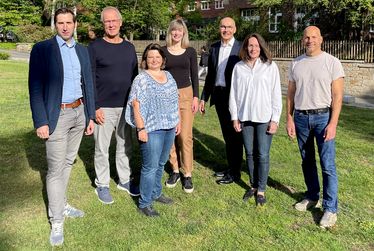The "Paper of the Month" 05/2022 goes to: Prof. Heindel and Prof. Weigel from the Clinic for Radiology
f.l.t.r.: Dipl.-Ing. Alexander Sommer (Clinic for Radiology), Prof. em. Hans-Werner Hense (Institute of Epidemiology and Social Medicine), Dr. Miriam Krischke (Center for Clinical Trials Münster), Dr. Laura Kerschke (Institute of Biostatistics and Clinical Research), Prof. Walter Heindel (Shared first authorship; Clinic for Radiology), Prof. Stefanie Weigel (Shared first authorship; Clinic for Radiology) and Dr. Joachim Gerß (Institute of Biostatistics and Clinical Research) (Photo: private)
For the month of May 2022, the "Paper of the Month" of the Medical Faculty of WWU Münster goes to:
Prof. Walter Heindel und Prof. Stefanie Weigel from the Clinic for Radiology for the publication:
Heindel, W; Weigel, S.; Gerß, J; Hense, H-W; Sommer, A; Krischke, M; Kerschke, L; TOSYMA Screening Trial Study Group
Apr 2022 | THE LANCET ONCOLOGY 23 (5)
Rationale for selection:
This publication describes a technical modification for early breast cancer imaging in a large screening program. In doing so, this study confirms smaller precursor examinations and shows in two prospectively randomized, large and representative groups of persons (n > 90,000) that a "Digital Breast Tomosynthesis" yields significantly better early detection results (detection rates) than the previously applied 2-dimensional mammography. This DFG-supported study will change and improve the practice of early detection examinations and thus has high medical and social relevance.
Background and fundamental question of the publication:
TOSYMA (TOmosynthesis plus SYnthesised MAmmography) is the first multi-center, randomized, clinical trial (RCT) assessing the performance of digital breast tomosynthesis (DBT) plus synthesized 2-dimensional mammography (s2D) compared to the standard breast screening method, 2-dimensional digital mammography (DM), in a population-wide program for early breast cancer detection.
Between July 2018 and December 2020, 99 689 women, aged 50-69 years, were randomly assigned (ratio 1:1) to DBT+s2D or DM. The detection rate for invasive breast cancers was 7.1 cases per 1000 women screened with DBT+s2D and in 4.8 cases per 1000 women screened with DM (Odds Ratio = 1.48 [95% CI 1.25–1.75]). The detection rate for breast cancers with tumor size pT1 was substantially higher in the DBT+s2D group than in the DM group (OR=1.73 [1.41–2.13]) while the detection of in-situ cancers (DCIS) was similar (OR=0.94). Recall rates for re-assessment were also similar between the study groups (OR=0.98). The detection rates with DBT+s2D were substantially higher among women returning for subsequent screening rounds and for those older than 60 years.
TOSYMA shows that the detection rate of invasive breast cancers with DBT+s2D is 48% higher than with DM alone. To further assess the prognostic implications of this finding for future screening strategies, the study population is prospectively followed to determine the interval breast cancer incidence at 24 months.


